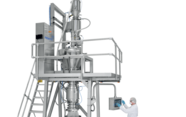
Integrating Environmental Thinking into Clinical Trial Logistics and Packaging Operations
The industry has spent decades optimizing distribution strategies to meet faster timelines. Now, it’s time to think about sustainability.
Deahne Baker, Jonathan Fuhr | | 7 min read

Deahne Baker
Sustainability is no longer just a buzzword. It is a central focus of business operations. What was once separate from day-to-day decisions, is now woven into corporate strategy and global value chains. With increasing pressure from consumers and investors, the biopharma industry faces a growing need to prioritize environmental, social, and governance (ESG) initiatives to make a real impact whilst also minimizing supply chain footprints.

Jonathan Fuhr
This fundamental shift is underscored by the rapid evolution of ESG standards, particularly in regulatory frameworks. In the EU and the UK, for example, sustainability and ESG compliance have become an integral part of expanding legislation, including carbon border adjustment mechanisms, emission trading schemes, extended producer responsibility requirements, and ESG disclosure standards. While many of these regulations remain in their infancy, the pattern is clear: global sustainability standards are tightening, with increasing scope and complexity.
This widespread adoption of Science-Based Targets Initiative (SBTi) commitments (founded by numerous large businesses to establish a framework for science-based net zero targets) further reinforces this transformation. Many of the largest pharmaceutical companies have already set near-term SBTi targets for their operations, suppliers, and supply chains, signaling an industry-wide shift toward sustainable practices.
In short, sustainability is no longer just a competitive advantage; it’s a license to operate. Companies that fail to adapt risk losing relevance.
Clinical trial logistics: no ‘one size fits all’ approach
Integrating sustainability into pharmaceutical and life sciences logistics is a challenge, but the difficulties are even more pronounced in clinical trial logistics.
The unique demands of precision logistics, where small-batch, time and temperature-critical biological samples and medicines must be securely transported with cold chain integrity and expert oversight, add further challenges. The industry has spent decades optimizing distribution strategies focused on quality and faster timelines, making sustainability often fundamentally at odds with operational realities.
The unpredictability, variability and urgency of clinical trial shipments means logistics providers must make real-time routing decisions based on precision, rather than emissions savings. As a result, sustainable alternatives, such as consolidated shipments or lower-carbon transportation modes, are often deemed operationally impracticable, or take a more considered, longer-term strategy to implement in a way that will not impact operations.
Similarly, a company’s infrastructure and operating model significantly influence its emission reduction strategies. Asset light businesses have vastly different options for reduction than those with owned assets.
The key takeaway is: driving impactful change requires a considered, customized sustainability approach – not a one-size-fits-all solution.
Real-World Lessons & Tips
Here are some lessons learned and suggested steps based on my company’s experience in implementing ESG initiatives while delivering real-world results.
Step 1: practical integration without disruption
For sustainability solutions to succeed, they must align with business priorities without introducing operational risks. They also take a leap of faith from the business – so go easy early. Initiatives that compromise efficiency, quality, or cost-effectiveness will struggle to gain traction as companies are unlikely to adopt them. Make sure the first thing you seek to roll out will succeed to gain trust and management buy in.
We chose to lead our efforts with a biofuels initiative because it did not disrupt workflows. This solution preserved operational flexibility by allowing booking operators to make time and quality optimized decisions at the shipment level. While they come at a cost delta, biofuels constitute a scalable, flexible emissions reduction solution with clear cost distribution, eliminating the need for long term commitments or capital-intensive expenditures. They can also be easily procured through third-party book and claim systems.
Sustainability, like logistics, often requires trade-offs, but this approach proved the cost of biofuel per shipment was far lower than anticipated, challenging the skepticism of early critics.
Step 2: equitable distribution of risk
It is also important to equitably distribute risk. Costs and responsibilities should be allocated to the stakeholders best equipped to manage them, ensuring financial viability and clear value for a company, shareholders, and clients alike. In my experience, pilot programs are essential for evaluating the operational and financial viability of new solutions before large-scale implementation. For example, in EV pilots, asset owners, or OSPs, may be reluctant to invest in high-cost, low-range vehicles. However, identifying high volume lanes near charging hubs can significantly enhance viability. Structured agreements, such as exchanging increased work volume EV adoption, help distribute costs without raising service charges, making sustainable solutions financially attractive and operationally feasible.
For any cross-value chain solution, make sure key components and risks – such as technical implementation, volume forecasting, cost allocation and emission savings auditing – are attributed to the right stakeholders.
Step 3: build trust through action, not promises
Trust in novel reduction mechanisms cannot be built through mere assurances; it must be demonstrated through implementation.
One of the challenges faced with our biofuel pilot in its early stages was the stigma surrounding its superficial resemblance to traditional carbon offsets. However, unlike offsets, which lack any ties to an entity’s operational boundaries, the biofuel pilot directly connected client spend to the fueling of sustainable biofuels within our network. Clients can see firsthand how their contributions translate into tangible and verifiable emissions reductions within their value chain.
Pilot programs, along with third-party auditing and transparent reporting, play a critical role in trust building by reaffirming credibility, transparency and measurable impact.
Sustainable packaging approaches
When discussing logistics, we cannot avoid talking about packaging. Anyone promising a singular sustainable packaging solution for pharmaceutical logistics is failing to grasp the intricacies of its impact. Sustainability in packaging is not only about the materials and production methods – the overall environmental impact also depends heavily on how the packaging performs throughout its entire lifecycle, including transportation and final disposal.
While manufacturers optimize for cradle-to-gate sustainability by using non-fossil-based resources and low-carbon production processes, these efforts will be entirely negated if logistics providers fail to consider the transportation phase in their solution design.
Major considerations in sustainable packaging include:
- Weight matters! A novel, low-carbon packaging material produced 2 kg heavier than its expanded polystyrene alternative may erase any emissions savings once it enters the emissions-heavy NFO networks common in clinical trial logistics.
- Circularity isn’t always feasible. While reusable packaging and circular models are highly valuable, they may not be viable in low-volume trade lanes where reverse logistics and repositioning cannot be guaranteed. If the environmental cost of returning empty reusable packaging outweighs its benefits, the sustainability advantage is lost.
- Inventory impact. Lower-carbon transportation modes, such as sea freight, greatly reduces emissions when repositioning reusable packaging. However, the longer transit times require higher inventory levels, increasing resource consumption and reducing reuse efficiency — factors that must be considered in a holistic sustainability assessment.
The answer to these challenges is not rigid sustainability mandates but rather a flexible, balanced packaging approach that applies the best packaging strategy for each shipment’s unique needs. Continuous innovation means evaluating and implementing new solutions while proactively tackling any disruptive intricacies head on.
Also important to consider in logistics is advanced technologies. Advanced technologies enable companies to automate trade-offs, assess and select the most cost-effective and sustainable solutions from a range of reduction levers. By leveraging real-time data and automation, businesses integrate data-driven assessments into daily operations. When applied to sustainability efforts, this approach ensures decisions are continuously optimized based on refined parameters, maximizing both efficiency and environmental impact
By integrating AI-driven lane optimization and decision making, logistics operators gain instant insights into cost versus sustainability trade-offs, ensuring transport route decisions not only align with both operational priorities and ESG goals, but also translate into real-world action. While leadership commitment to ESG is vital, it is the frontline, on the ground teams making the daily decisions that drive real change.
Turning sustainability vision into action
Sustainability in logistics is not just about trade-offs and higher costs — nor is it an impossible feat. Optimizing operations while reducing environmental social impact is not only feasible, but essential. Taking the first steps toward sustainability is the beginning of a journey that brings both new solutions and fresh challenges. ESG initiatives are applicable to every facet in a business.
Some critics claim that sustainable businesses and practices in clinical trial logistics are unviable, and developing plans to reduce waste and emissions is a futile effort. However, there is no greater way to make this a certainty than accepting their narrative.
Developing a sustainability program involves a deep understanding of your organization, supply chains, and operational infrastructure, along with stakeholder buy-in and trust building through pilot programs. The key is to embrace agility, continuous learning, and a willingness to pivot when certain solutions prove ineffective. Every sustainability journey has a starting point — the real challenge is committing to the path forward.
Senior Director, Global Sustainability and Senior Legal Counsel at Marken
Senior Manager, Global Sustainability at Marken



















